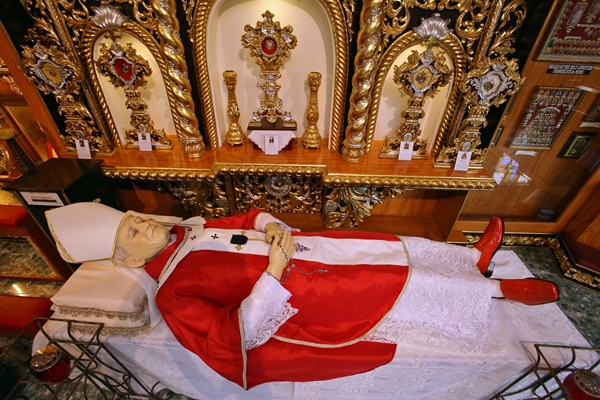
A life-sized image of Pope John Paul II is surrounded by relics of other saints in the Chapel of Holy Relics at Tabor Hill, barangay San Jose, Talamban, Cebu City. (CDN PHOTO/JUNJIE MENDOZA)
Relics of John Paul II can be found in a hillside chapel in barangay San Jose, Talamban in Cebu City.
A hair strand and blood stain, considered first-class relics of the late Polish pope who will be officially declared a saint on Sunday by the Vatican, are on display for public veneration in the Chapel of Holy Relics in Tabor Hill.
A piece of skin of John XXIII, the other pope to be canonized this weekend, is also found there along with a chasuble or liturgical vestment that he once wore.
The human remnants are preserved in glass medallions and mounted on elaborate gold stands or reliquaries next to photos of the late popes.
“If people come to this chapel, we tell them about the lives of these saints. They should not visit this place just to kiss these relics,” said Fr. Dennis Duene Ruiz, chaplain and curator, who acquired the items from contacts in Rome, Italy where he served as assistant in the Office of the Holy Relics for five years.
Honor
“If people come here and venerate these relics without imitating the lives of saints, what a waste it would be,” he said.
The ancient practice of venerating relics by the Orthodox and Roman Catholic faithful dates back to the 4th century wherein pieces of bone or garments of martyrs and holy men were kept to honor them.
Fr. Ruiz clarified that the faithful do not “worship” relics since worship is something due to God alone.
Canon Law also forbids the selling of sacred relics, which require permission from the Vatican to be “validly alienated or perpetually transferred”.
On display is also a construction hard hat used by Pope John Paul II in one of his visits to an Italian factory and the cornerstone of Tabor Hill which he had blessed in 1997.
Faith-filled life
What greets visitors in the hall is a life-size replica of the crimson-robed pontiff laid out on a table as he would appear while lying in state.
The image is dressed in a red chasuble, red leather shoes, a white miter or headdress and a rosary clasped in his hands.
The chapel is supervised by the Order of the Discalced Augustinians (OAD) and houses over 900 relics of different saints.
Almost all relics kept in the chapel are first-class relics, which are physical remnants of a saint such as pieces of bone, blood or other body parts.
Their garments are considered second-class relics. Any object touched by the saint, including the tomb, is a third-class relic.
The ancient tradition of venerating relics continues in Tabor Hill where a hair strand, blood stain and piece of skin of Pope John Paul II and Pope John XXIII are kept in glass medallions mounted on gold reliquaries, along with a hard hat and liturgical robe used by the late popes. (CDN PHOTO/JUNJIE MENDOZA)
True home
“In all, relics remind us of the holiness of a saint and his cooperation in God’s work. At the same time, relics inspire us to ask for the prayers of that saint and to beg the grace of God to live the same kind of faith-filled life,” writes Fr. William Saunders, president of Notre Dame Institute in Alexandria in the EWTN website.
Fr. Ruiz recalled meeting Pope John Paul II in 2005, days before the prelate died.
“Actually, his hands were shaking uncontrollably from Parkinson’s Disease. He could hardly speak when I met him. I told him, ‘Your Holiness, I’m one of the fruits of World Youth Day.’ And he said, ‘Bene, bene’ (good),” said Fr. Ruiz, who along with over 150 people had a private audience that day with John Paul II in Rome.
Ruiz said that one of the most important values he learned from the Polish pope was his detachment.
“While he journeyed with the world, he knew he’s not of this world. Our true home is heaven,” he said.
“Pope John Paul II showed us what the gospel of joy is all about. He was able to show us how to be joyful amid the pain and suffering he went through when he was still alive,” he added.
John Paul II visited Cebu on Feb. 19 and 20, 1981 when he presided over an open air Mass at the former Lahug airport and spent the night at the Archbishop’s residence.
He died at the age of 84 on April 2, 2005. Born Karol Józef Wojtyla, Pope John Paul II was the second longest-serving pope in history and the most travelled, visiting 129 countries.
Considered one of the most influential leaders of the 20th century, John Paul II helped end communist rule in his native Poland and eventually all of Europe.
On the other hand, Pope John XXIII made his mark in history by opening the Second Vatican Council in 1962, which ushered in many reforms. The Italian pope whose birth name was Angelo Giuseppe Roncalli died of stomach cancer in 1963 and didn’t live to see the completion of the council.